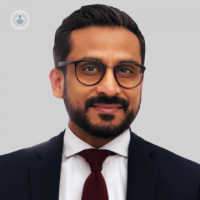Interventional cardiology: a deeper look inside
Written in association with:What is interventional cardiology? Leading consultant interventional cardiologist Dr Niket Patel shares his expertise on the techniques and treatments that are considered part of interventional cardiology. The London-based consultant discusses the different techniques, when they are used, how this particular area of cardiology has advanced over the past few years, and how this has made the treatment more widely available to patients who previously might not have been eligible to avail of it.

What is interventional cardiology?
Interventional cardiology is a part of cardiology that uses various invasive technologies and techniques to investigate the heart. It is also used to treat numerous cardiac conditions, such as coronary disease, including heart attacks, heart valve problems, and structural heart disease. Invasive techniques involve gaining access to the body’s arterial system normally either from the radial artery, located in the wrist, or from the femoral artery, accessed through the top of the leg. Interventional cardiology thus allows various treatments to be performed on the heart without open-heart surgery.
Although it can be done under general anaesthetic, normally it is performed under a local anaesthetic to numb the access point to the body’s arteries. The use of X-rays helps guide the various pieces of equipment used through the vessels to the heart, while ultrasound echocardiography is used to show the structure of the heart.
When deciding whether a patient is a suitable candidate for interventional cardiology, the risks and benefits need to be considered, in addition to the patient’s medical condition.
What is the difference between invasive and non-invasive investigations?
While invasive investigations involve gaining access to the heart through a blood vessel, non-invasive assessment techniques are used to look at the heart without gaining access to the body, offering a way of looking at the structure and function of the heart without causing any damage to the body. Examples of non-invasive technologies include ECG monitoring, ultrasounds, stress echocardiography, CT scans, and MRI scans.
Patients should always discuss the benefits of the different approaches to investigating the heart with their cardiologist. There are merits in each investigation, but guidance is provided as to which is most suitable in the individual’s case based on symptoms, examination findings, and the influences of other medical conditions.
Devices have been developed to support the heart during an operative procedure. These devices can aid the regular function of the heart, by pumping and supplying blood to the body, while the patient undergoes surgery, making it safer.
Additionally, the advancements in structural intervention to the heart have revolutionised treatment options for patients. For patients suffering from aortic valve disease, for example, who may have a narrowing of the aorta valve or a collapsed valve, a new valve can be put in place called a TAVI. If a patient has a leaky mitral valve, similarly this condition can now be treated to allow the valve to close properly. The techniques used have become more refined and safer over the past decade.
What advancements have been made in interventional cardiology?
Over the last decade, interventional cardiology has benefitted from many advances.
To look within the heart arteries, various techniques have been developed using ultrasound and a light telescope called an OCT. They provide a more detailed view of the artery and help in understanding how heart artery problems affect the function and flow of blood. Treatment of the arteries has also improved, with techniques that help us deal with some more difficult issues that cause narrowing. For example, tough material that is often made up of calcium can build up causing a blockage. Tools have been developed to treat this efficiently, from a balloon that emits a certain sound frequency capable of breaking up the calcium, to diamond tip spinning drills that break down the calcium and create a passage.
Advancements in technology offer a more detailed understanding of the smaller blood vessel. Stents can help with issues affecting the branch point of arteries. Microvascular dysfunction can now be accurately assessed by looking at the blood flow and coronary physiology.
How do these advances benefit patients?
Thanks to these advancements, a wider group of patients can avail of interventional cardiology treatments. Historically, perhaps patients would have been turned down due to higher risks and other medical conditions. Techniques have been refined, meaning that sicker patients or patients with acute illnesses, like heart attacks, can now undergo surgery more safely.
Overall, the treatment of patients in a more meticulous, precise, and guided way has helped achieve better overall outcomes.
All of these treatments have risks and benefits that need to be considered and discussed with a cardiologist before undergoing them.
If you are interested in booking a consultation with the revered Dr Niket Patel, you can do so by visiting his Top Doctors profile.


